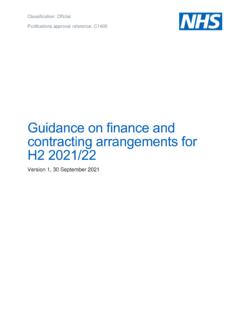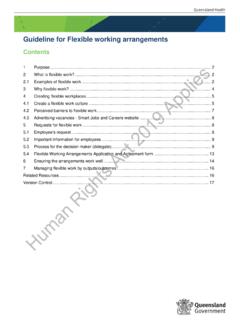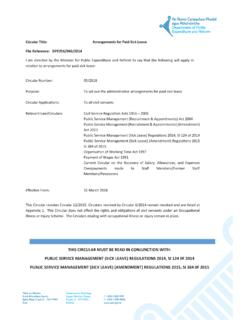Transcription of HSE information sheet
1 hse information sheet organisational change and major accident hazards Introduction This information sheet provides guidance for employers responsible for major hazards on how to manage the impact of organisational change on their control of the hazards. It covers offshore and onshore oil, gas, and chemical installations and it will also apply to railway operators and nuclear installations. Following the guidance means that you will be complying with your general legal responsibilities, although there can be additional requirements specific to your industry (see Legal requirements). It is for employers and senior managers dealing with organisational change, and anyone involved in planning or implementing such change.
2 It will also be helpful to employees and, trade union or staff representatives and safety representatives. It describes common pitfalls to look for, suggests a three-part framework for managing organisational change, and explains your legal duties as the employer. organisational change is a normal and inevitable part of business life in all sectors. But organisations associated with major accident hazards have a greater potential for disastrous consequences and higher costs in terms of lives and money. These consequences mean that organisations managing major hazards must aim for much higher reliability than is normally necessary in commercial decision making.
3 1 assess .. restructuring .. Overstressed manager In 1992, at Hickson & Welch, in Castleford fires killed five employees during the cleaning of a vessel containing potentially unstable sludge. Because of a recent company reorganisation, the cleaning task had been organised by inexperienced team leaders reporting to an overworked area HSE incident report said: Companies should the workload and other implications of to ensure that key personnel have adequate resources, including time and cover, to discharge their responsibilities. organisational change is often an opportunity to improve health and safety, for example though reappraisal of safeguards or clarification of personal accountabilities.
4 However, HSE s experience is that in many instances organisational changes are not Chemical information sheet No CHIS7 analysed and controlled as thoroughly as plant changes, resulting in reduced defences against major accidents, sometimes with fatal consequences (as in the Hickson & Welch incident). This is because, unlike management of plant change, impacts of organisational change are less well understood, and there is a lack of robust, generally accepted approaches to ensuring safety. This guidance aims to help employers manage change that impacts on health and safety. What changes? Many forms of organisational change can affect management of major hazards.
5 Changes could include: changes to roles and responsibilities, organisational structure, staffing levels, staff disposition or any other change that may directly or indirectly affect the control of the hazard. The following are some common management terms for such changes: business process re-engineering; delayering; introduction of self-managed teams; multi-skilling; outsourcing/contracterisation; mergers, de-mergers and acquisitions; downsizing; changes to key personnel; centralisation or dispersion of functions; changes to communication systems or reporting relationships. The main focus of this guidance is on change at operational and site level.
6 It is also relevant to changes at corporate level which can have a significant impact on safety at operational level. Examples of this include changes in reporting relationships, objectives, resources, management system, available expertise for design, engineering support, procurement and so on. Although the guidance is specifically about major accident prevention, the processes outlined should have benefits for other aspects of health, safety and environmental management, and even commercial risk. How to use this guidance This guidance sets out a three-step framework: Step 1 - Getting organised for change Step 2 - Assessing risks Step 3 - Implementing and monitoring the change Each step is explained and various important topics are covered which you should address at each stage of the process.
7 Use these steps to plan and manage your organisational changes. 1 Figure 1 Managing organisational change procedure workload STEP 1: GETTING ORGANISED Step 1 Getting organised Have a strong policy Make senior-level managers accountable Have a clear change-management Communicate and include everyone Review and challenge Step 2 Risk assessment Identify the people involved Identify all changes Assess the risks Consider human factors, competence and Test scenarios Step 3 Implementing and monitoring Provide enough resources to make the change safely Monitor risks during change Keep your plan under review, track actions Monitor performance after change Review your change policy Policy The organisation should have a clear policy for management of organisational change.
8 This should set out principles, commitments and accountabilities in relation to impact on health, safety and the environment. Ideally the policy should commit to proportionate consideration of all organisational changes, large and small; as even those not at first connected to safety need to be given consideration to confirm whether or not they may have indirect impacts on safety. 2 influence; process; assessment; Getting organised checklist Don t make too many simultaneous changes, resulting in inadequate attention to some or all. Don t delay or defer safety issues compared to other aspects considered more pressing, because: it is seen as a side issue; it is delegated to people with inadequate it is not considered early enough in the change inadequate time or resource is allocated to the teams making decisions are too inward looking; there is lack of objectivity; objectives are passive, maintaining rather than improving standards; appropriate management controls are missing.
9 Commitment and resources Although the motivation for the change may be commercial, and not obviously connected with safety, major accident prevention must be regarded as core business, not a side issue. Senior management need to demonstrate a clear commitment to safety by their actions, from the outset. There should be a distinct safety focus within overall change processes, with positive objectives. Make a senior, highly influential manager the sponsor or champion for this. They should ensure the safety aspects of the change receive an appropriate level of resource and attention. The effort and resource put in must be proportionate to: the complexity of the change; the scale of the hazards concerned; and the degree to which the change may impact on the management of major hazards.
10 This can be by categorising of changes, with greater importance and a higher level of management approval for more safety-significant categories. Clear systems organisational change should be planned in a thorough, systematic, and realistic way. You should follow a documented and structured procedure for each element of organisational change management. This is similar to the processes for managing plant change. The following should be clear: Identify the processes or activities that are to be carried out (to ensure that risks arising from the change are identified, assessed and reduced to as low as is reasonably practicable). Set out the protocols to be followed.

















